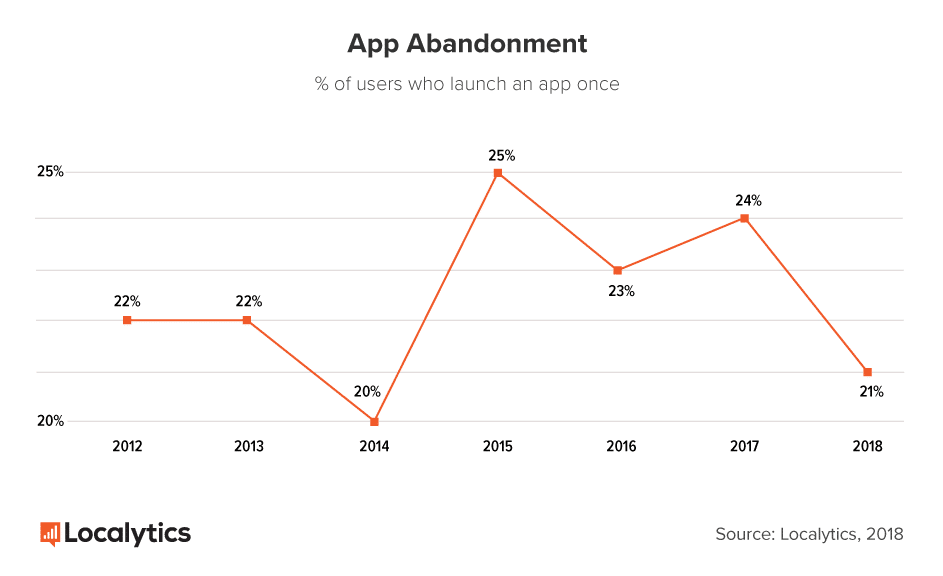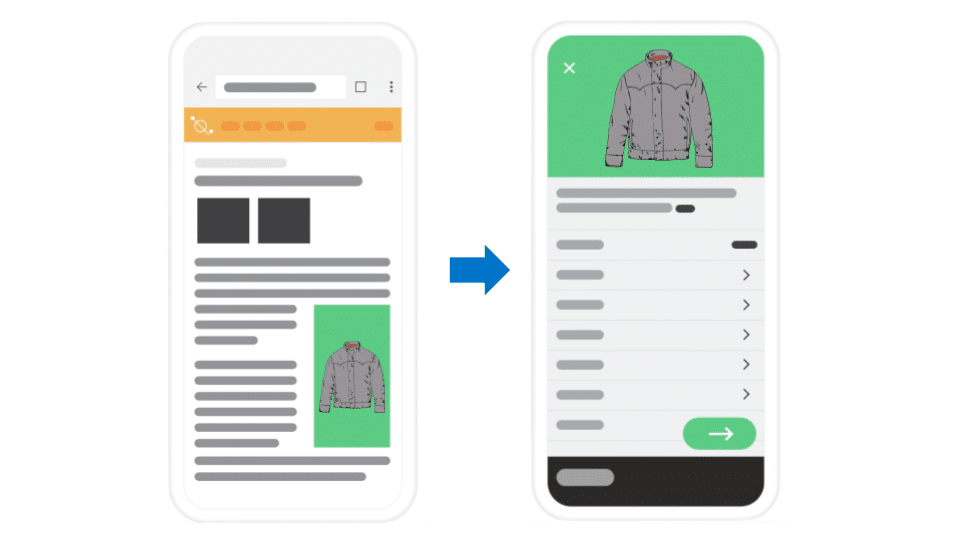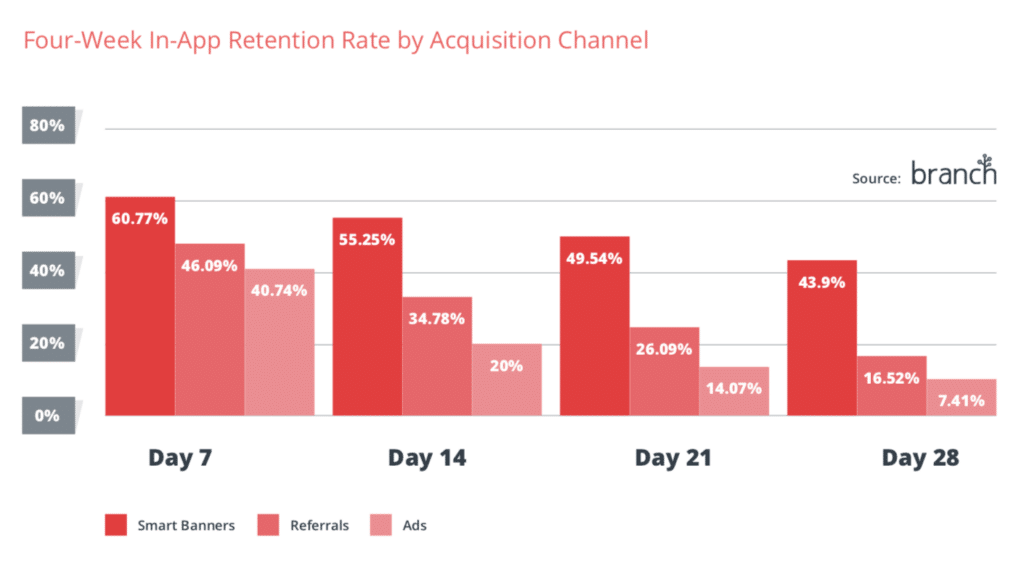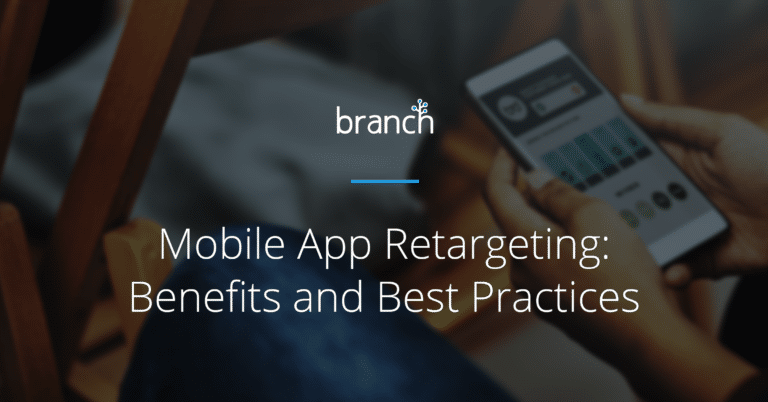Many mobile users, myself included, download an app as a result of a specific offer, need, or use case. But after that first open, 1 in 5 users forget about that app entirely. To prevent this churn – and make sure users return to apps and convert – mobile marketers and product managers have to create effective strategies for retargeting those app users.
Let’s set the stage with a definition.
What is Mobile App Retargeting?
Mobile app retargeting refers to ad campaigns that target people who have previously visited your mobile app. Based on specific mobile user behavior, you can serve personalized ads to encourage users to re-engage, re-install, or complete a down-funnel conversion.
Why Do You Need to Retarget Your Mobile App Users?
A Localytics study shows that 21% of mobile users will abandon an app after just one use. Their data also shows that while retention rates vary slightly by industry, 80% of users across all verticals abandon an app they downloaded by month 3.

This may be related to the fact that, according to AppAnnie, the average mobile user in the US, South Korea, Japan, and Australia has over 100 apps on their smartphone.
This means you’re potentially fighting against 100 other apps for user time. Staying top-of-mind and giving users a compelling reason to return to your app is essential to survival. Apps that fail to keep users engaged are doomed to be deleted – and risk missing out on valuable revenue.
That’s where deep linked mobile app retargeting can help.
Benefits of Retargeting Mobile Users
Beyond re-engaging the users you’ve already spent money acquiring, implementing mobile app retargeting enables you to:
- Drive more engagement (increase app visits, in-app activities)
- Boost app user retention (increase app visit frequency, decrease churn)
- Increase down-funnel conversions (increase in-app conversions, sign-ups, purchases)
So, what does this look like?
Say you have a retail app and one of your app users views a jacket, but then closes out of the app without completing the purchase. Through a mobile app retargeting campaign, you can serve this user an ad for that jacket to encourage them to return to the app and purchase.

Now that we know the value of mobile app retargeting across channels, let’s look at some best practices to help you maximize the ROI of your retargeting campaigns.
5 Best Practices for Mobile App Retargeting
1. Don’t just retarget lapsed users
Many apps rely on retargeting solely to win back customers who have stopped using their apps. While it’s critical to re-engage lapsed users, it’s equally as important to prevent app users from lapsing in the first place.
As shown in the Branch Industry Report, users drop off quickly a week after initial install. While retention rates vary by how app users were initially acquired, that first week is a crucial time to retarget users, pull them back into your app, and keep them engaged.

If you don’t remind users to return to your app soon after they install, there’s a very high chance they’ll never come back.
2. Give retargeting the same design love as UA
You allocate significant design resources to your paid user acquisition campaigns, so why not put the same effort into your retargeting campaigns?
The quality of your creative assets has a direct impact on the effectiveness of your campaigns – regardless of where these campaigns fall in the customer journey.
Another reason to focus on creative quality? Studies have shown consumers are exposed to anywhere between 3,000 and 20,000 ads per day. Make sure yours will cut through the clutter.
3. Always personalize
Choose an ad partner that enables ad personalization by user behavior, intent, etc. Criteo recommends personalized retargeting for apps with large inventories, broad customer bases, and/or customers with (a wide range) of specific tastes.
Shopping cart abandonment is a perfect example of personalized retargeting. Say a mobile user is perusing your retail app and adds a pair of jeans to their cart. They then get distracted and leave the app. You (the app) can use the item in that user’s shopping cart (in-app event data) in personalized retargeting ads (e.g. display or social ads) to remind that user of their interest and encourage them to complete the transaction. By clicking the deep linked ad, the user will be seamlessly routed back to their cart within the native app – rather than to the mobile web or the app’s home screen.
With this ad, you’ve re-engaged an app user, prompted a conversion, and collected useful user behavior data to inform future retargeting campaigns.
Personalization also has a positive impact on retention: A study by Localytics shows “apps that mostly target their campaigns see an 18 percentage point advantage in retention over apps that send mostly broadcast campaigns.”
4. Know your audience
Historically, retargeting has been limited to a website or an app. But you can’t get a full picture of user behavior and intent – and a clear understanding of your customers – if user journeys are fragmented.
With the introduction of Branch’s attribution model, user’s link graphs can now be connected across web and app platforms, allowing mobile marketers to understand the full customer journey and retarget across platforms. Because the most effective app retargeting is as cross-channel as your users are.
Let’s go back to our earlier abandoned cart example.
Say this user saw the retargeting ad while browsing Facebook on their desktop, then opened the app on their phone to complete their purchase. Branch’s cross-channel attribution would capture the role that ad played in the customer’s journey (even if they didn’t click the ad), while legacy attribution providers would be unable to connect these dots.
5. Measure carefully to maximize ROI
Mobile advertising is expensive, so it’s critical that you monitor campaign performance closely to shift spend toward high-performing campaigns and away from low-performers to maximize return.
Branch’s Universal Ads solution helps you optimize app retargeting campaign performance and track your full return on investment in one place, using data from every channel and platform. Powered by Branch’s attribution solution, complex conversions that legacy systems miss (or worse, put into the wrong bucket) now show up where they belong. This means 30% more data to leverage to optimize your campaigns and maximize ROI.
Follow these best practices to ensure your mobile app retargeting campaigns are optimized to drive app engagement, retention, and ultimately conversions.
With the help of Branch, you can automate your personalized retargeting campaigns to reach users wherever they are and show them what they’re most interested in – increasing the likelihood that they’ll return to your app and convert.
Ready to maximize the return on your retargeting investments? Learn more about Branch’s Universal Ads or contact our sales team today.






















